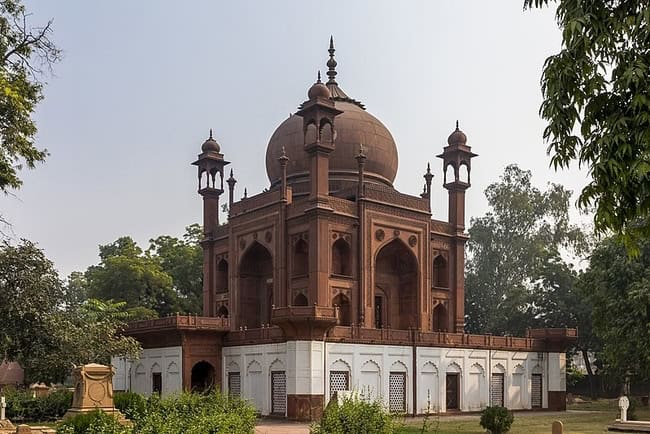The tomb of John Hessing, is a still more splendid edifice, being a copy, in red sandstone, of the famous Taj Mahal. The tomb, which was completed in or about the year of the British conquest, bears an inscription in good English, setting forth that the deceased colonel was a Dutchman, who died Commandant of Agra, in his 63rd year, 21 July 1803, just before Lake’s successful siege of the place. The Tomb was built by John Hessing’s wife, Alice.
Hessing was born in Utrecht, Holland, in 1739, and came to India as a 24-year-old. He served under the Nizam of Hyderabad and the Marathas, and was later given the command of the first two battalions of the newly raised Scindia army. Hessing’s tomb is located in the Padretola, or Padresanto, a Christian cemetery in Agra.
After the death of Maharaja Mahadaji Scindia, he continued to serve under Maharaja Daulat Rao Scindia. When he could no longer actively serve due to ill-health, Hessing was made the Commandant of Agra Fort by Scindia. He died in 1803 and was buried in the Roman Catholic Cemetery in Nehru Nagar, Agra.
This tomb stands on a square platform which is 11-1/4 feet high and 58 feet side, containing a crypt with the real grave and corridor around it. Twin stairways are also attached to it on the western of the side with a platform.

It is essentially a Mughal design. Small towers are attached to the central iwan-frame. They are crowned by pinnacles. Square turrets, 2 feet side are attached to the corner of the tomb. These have vertical flutes and are surrounded by beautiful square chhatris. The tomb is roofed by a double dome, crowned by mahapadma (Sheath of lotus petals) and Kalash finial. With pinnacles and chhatris of the turrets, it makes up a perfect superstructure. The interior is square chamber 17-3/4 feet side with ribs and panels soffit.
The Cenotaph bears an inscription in English. As a whole, it is perfectly balanced and beautiful building and rightly called “The Taj in Miniature”. This is, in fact, the most beautiful tomb of a European in Agra and probably in India. Though a Dutch tomb, it belongs, in letter and spirit to Agra and to the art of the Jamuna-Chambal region. It marks continuance of Mugal ‘ideas’ feelings and skills in the 19th century A.D.
[source_without_link]SIASAT NEWS[/source_without_link]

